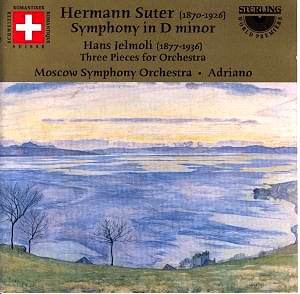Bo Hyttner's Sterling label opens up another vein in
symphonic music: the music of Hermann Suter one of the Swiss traditionalists.
From the same genre Sterling have already recorded the eight symphonies
of Hans Huber written between 1881 and 1921. Awaiting appraisal are
the two symphonies by Robert Hermann (1895, 1906), Fritz Brun's ten
(1901-1953), Robert Oboussier's 1936 symphony and Walther Geiser's symphony
of 1953.
The four movement symphony was written on the cusp
of the Great War and was premiered in Zürich and Basel in 1915.
Suter's friend the composer-conductor Siegmund von Hausegger (who, according
to Adriano, wrote a splendid Natur-Sinfonie) conducted the work
in Berlin in 1916. Performances also took place in Hamburg (1917) and
Leipzig (1918).
After a rather overcast and unruly nebuloso and
marziale e fiero first movement in which the exemplar is surely
Richard Strauss comes a witty and bombastic Capriccio militaresco.
The brass choir have that commanding ruptured aureate tone that mediates
the defiant and the heroic. The glowing prayer-like adagio has
writing for the violins that may well have coloured Othmar Schoeck's
Sommernacht. The Rondo finale has a modicum of the levity of
the second movement coupled with a romantic striving that sounds like
a strenuous Schumann. The brass are recorded with satisfying emphasis
so if you love brilliantly recorded trumpets, trombones and horns you
must not miss this even if a certain heaviness afflicts the finale.
The mood changes from movement to movement spell an eccentric work.
Otherwise this is certainly something to enjoy.
Suter was a pupil of Huber. He found a modern intensity
of expression that eluded Huber almost completely. Our appetites have
now been sharpened by the experience of the Symphony to hear the 1921
Violin Concerto as well as the highly regarded oratorio, Le Laudi
di San Francesco d'Assisi.
The three pieces by Jelmoli follow after too short
a gap. They are the equivalent of the light incidental music of Roger
Quilter and Norman O'Neill in England or of Massenet and Fauré
in France. This is music written in the nature of an intermède
or entr'acte. One can easily imagine Beecham falling for the elegant
charm of Jelmoli's Intermède Lyrique.
An idiosyncratic Straussian symphony contrasted with
a bonne-bouche suite. Both novelties.
Rob Barnett
